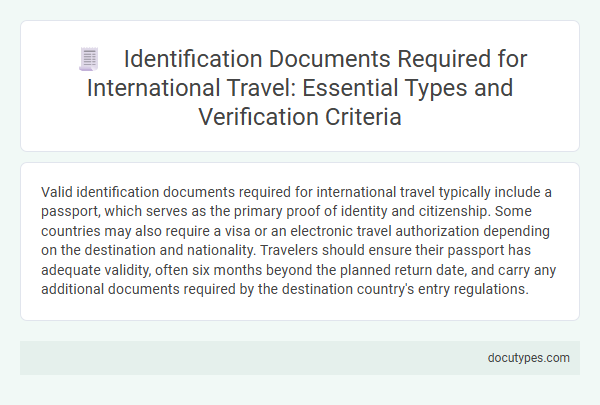Valid identification documents required for international travel typically include a passport, which serves as the primary proof of identity and citizenship. Some countries may also require a visa or an electronic travel authorization depending on the destination and nationality. Travelers should ensure their passport has adequate validity, often six months beyond the planned return date, and carry any additional documents required by the destination country's entry regulations.
Overview of Identification Documents for International Travel
What identification documents are required for international travel? A valid passport is the primary document needed for crossing international borders. Some countries also require a visa or additional identification depending on the destination and travel purpose.
Types of Identification Documents Accepted Globally
International travel requires specific identification documents to verify identity and citizenship. Different countries and airlines recognize various types of identification for border entry and exit.
- Passport - Universally accepted travel document issued by a country's government, containing biometric data and citizenship information.
- Visa - Official endorsement or stamp placed within a passport allowing entry to specific countries under defined conditions.
- National ID Card - Some countries accept government-issued national identity cards for travel within specific regions, such as the European Union's Schengen Area.
Passports: Standards and Security Features
Passports are the primary identification documents required for international travel, serving as proof of identity and nationality. They adhere to strict international standards set by the International Civil Aviation Organization (ICAO), ensuring global recognition and compatibility. Your passport incorporates advanced security features like biometric data, holograms, and watermarks to prevent forgery and enhance traveler safety.
National ID Cards in International Travel
| Identification Document | Purpose in International Travel | Key Features | Countries Accepting National ID Cards |
|---|---|---|---|
| National ID Card | Used as proof of identity and citizenship at border checkpoints; alternative to passports in certain travel zones | Contains personal information including full name, date of birth, photograph, unique identification number, and nationality; compliant with international security standards such as ICAO | European Union member states, Norway, Switzerland, Turkey, and some Caribbean countries allow travel using National ID Cards without a passport within specific agreements or regions |
| Passport | Primary travel document required for international journeys; establishes identity and nationality globally | Includes biometric data, official stamps and visas, and adheres to ICAO standards | Accepted worldwide for international travel |
| Visa | Authorization issued by a country granting permission to enter, stay, or transit | Can be stamped, sticker, or electronic endorsement linked to the traveler's identification document | Required by most countries depending on nationality and destination |
Visa Requirements and Supporting Documentation
Identification documents required for international travel primarily include a valid passport and, in many cases, a visa specific to the destination country. Visa requirements vary depending on your nationality and the purpose of travel, such as tourism, business, or study.
Supporting documentation often includes proof of onward travel, accommodation details, and financial evidence to meet visa application criteria. It is essential to check the official embassy or consulate guidelines to ensure all necessary documents are prepared before departure.
Electronic Travel Authorizations (ETAs)
International travel requires specific identification documents to ensure smooth entry and exit across borders. Electronic Travel Authorizations (ETAs) have become a key component in the identification process for many countries.
- Electronic Travel Authorization (ETA) - A digital permit linked to your passport that pre-approves entry to the destination country.
- Passport - A valid, government-issued travel document necessary to obtain an ETA and enter foreign countries.
- Additional Identification - Sometimes required depending on the destination, including visas, proof of onward travel, or vaccination certificates.
Your ETA must be approved before boarding international flights to ensure compliance with immigration regulations.
Special Travel Documents: Diplomatic and Emergency Passports
International travel requires valid identification documents, with special travel documents like diplomatic and emergency passports serving unique purposes. Diplomatic passports are issued to government officials and diplomats to facilitate official travel and grant specific privileges.
Emergency passports are temporary travel documents issued to citizens who have lost their regular passports or need urgent travel authorization. These documents are typically valid for a limited period and may have restricted destinations. Understanding the appropriate use of diplomatic and emergency passports ensures smoother international travel experiences.
Biometrics and Digital Identification for Border Control
International travel requires valid identification documents, with passports serving as the primary proof of identity. Many countries increasingly integrate biometrics, such as fingerprint and facial recognition, for enhanced border security.
Digital identification systems streamline passenger verification, reducing wait times and improving accuracy at checkpoints. Biometric passports and eVisas are becoming standard, supporting fast and secure border control processes.
Verification Criteria for Authenticity of Travel Documents
International travel requires valid identification documents such as a passport, visa, and sometimes a national ID card. Verification criteria for authenticity include holograms, biometric data, and embedded security features like watermarks and microprinting. You must ensure these documents meet the official standards set by the destination country's immigration authorities.
What Identification Documents Are Needed for International Travel? Infographic

